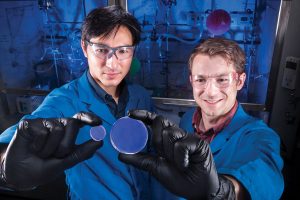Blueshift Optics and Sandia Partner to Commercialize Organic Glass Scintillators
A radiation detection material originally developed for national security applications at Sandia is headed into the commercial arena.
Sandia National Laboratories and California-based startup Blueshift Optics are partnering to commercialize Organic Glass Scintillators (OGS), an award-winning technology that was initially developed at Sandia to advance radiation detection materials.

Sandia issued its first nonexclusive commercial license to Blueshift for OGS in May 2021. The license for OGS allows Blueshift Optics to sell products as well as develop in-house manufacturing procedures and research and development. Although interest in the Organic Glass Scintillator (OGS) technology for nuclear physics and medical imaging applications has grown in recent years, its production hasn’t expanded beyond the lab until now.
The license includes the use of two granted U.S. patents as well as the option to license additional patents. Blueshift Optics intends to build in-house expertise to improve the technology and develop proprietary manufacturing techniques relevant to commercialization.
Blueshift was awarded funding in January 2022 from the DOE Small Business Innovation Research (SBIR) and Small Business Technology Transfer (STTR), which aim to advance DOE-supported science and technology into products and services. The company also received Small Business Innovation Research (SBIR) funding for the National Science Foundation to develop neutron detector arrays for nuclear physics and neutron scatter camera applications. The SBIR is a competitive program that encourages small businesses to engage in federal research involving technologies that could lead to commercialization.

Joey Carlson, a former Sandia employee, left the labs on Entrepreneurial Separation to Transfer Technology (ESTT) to start up Blueshift Optics in 2020. He says OGS is being used in nuclear physics research experiments around the world at entities such as the Large Hadron Collider.
Blueshift’s main product is called OGS 100, and Carlson says he anticipates that applications for the technology will include nuclear facilities, national labs, as well as ports of entry and border crossings. The technology also has potential in medical fields.